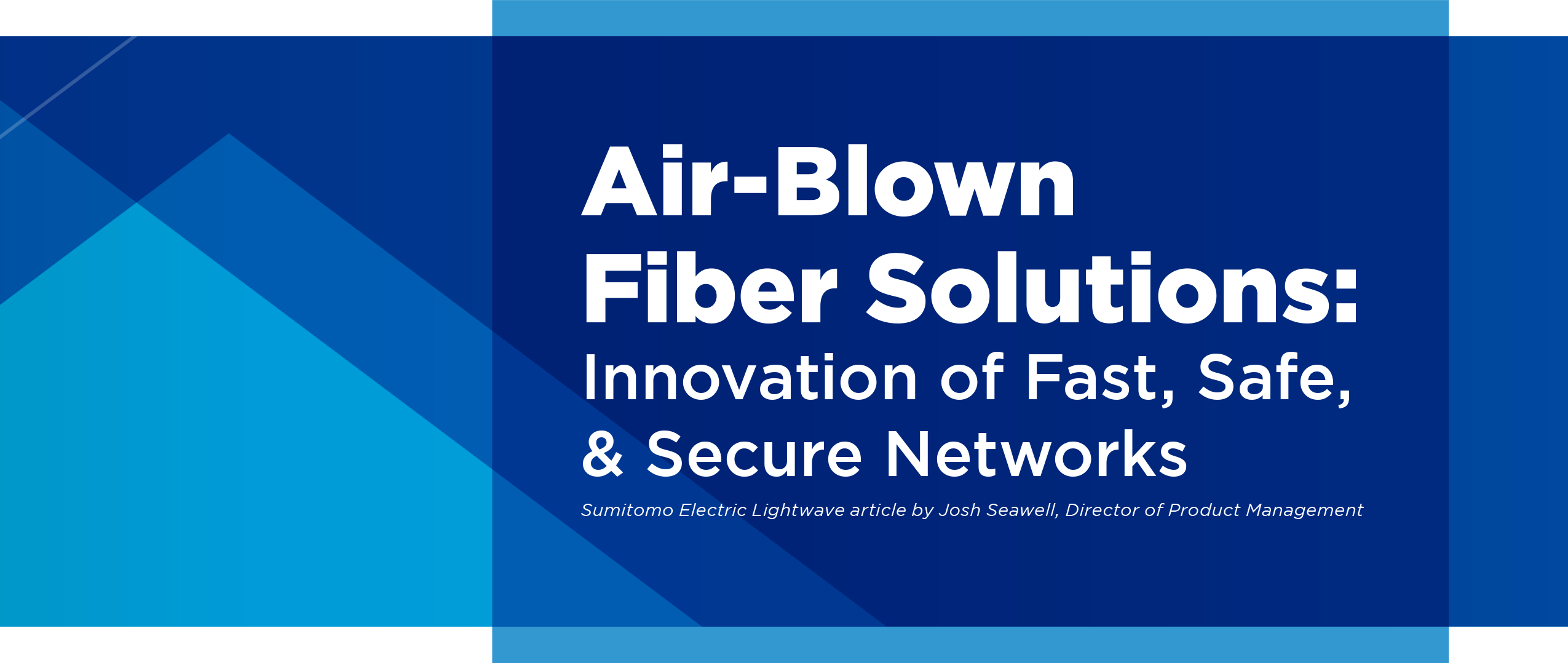
There are many options for building a fiber optic network, but not all deliver the same level of value for both during installation and through the span of the network’s active use. With the goal of maximizing these values, there are considerations each with their own weighted priority for making the best choice of available network solutions. Capability of meeting the requirement of the network, overall cost, and quality usually sit high on this list, but others with significant priority include time frame, safety, and security of the network. This article explores a network solution that is advanced in the arena of time frame, safety and security while also exceeding the expectations and requirements for the network demands, cost and quality.
Are you aware of the latest innovations in the air blown fiber (ABF) solutions available today? ABF has seen changes that yield substantial value increase to an already feature rich solution. Most are already aware of the advantages ABF provides in speed of deployment for both initial installation and especially when moves, adds or changes (MACs) occur. Once the tube pathway is in place, which would be installed similarly to the installation of conventional cable, the fiber bundles are then installed/blown-in in a matter of minutes. This benefit is more significant in the MACs phase of a network, which is typically frequent over the network’s span of active use. Installing conventional cabling for these MACs would typically take days or even weeks to complete. However, with ABF, a new fiber bundle can be installed in just minutes, which translates to big cost savings.
As mentioned above, ABF has seen innovations that now add to its speed of deployment feature. Traditional fiber bundles are constructed of single fibers grouped together in subunits within the bundle construction. These fiber bundles were only available up to 24ct for many years and 48ct was added only within the last decade. In very recent years 72ct has been added as an option and even higher counts are on the horizon. This fiber count increase is significant for speed of deployment. Prior to 72ct, if the network fiber requirement was 72, then three 24ct fiber bundles would have to be installed. Now the same requirement can be installed in one third of the time.
Additionally, installing one 72ct fiber bundle versus three 24ct fiber bundles only utilizes one third the tube space leaving the other two tubes available for future network expansion. But the innovations that improve speed of deployment do not stop when fiber count increases. The new 72ct fiber bundle versions were developed utilizing advancements in fiber optic ribbon technology. Legacy 12ct fiber optic ribbons utilize a construction that sets exact fiber to fiber separation as well as minimizing the fiber to fiber offset. This is critical in order to perform fusion splicing of all 12 fibers and achieve a low loss fusion splice, typically 0.05dB or less across all 12 fibers. This construction yields a flat 12ct ribbon and cables constructed by stacking 12ct and up to 36ct ribbons. Today 12ct ribbons can be constructed with specifically placed separations between fibers within the ribbon matrix. These separations create a web effect which allows for the ribbon to be pliable or roll-able (AKA Freeform Ribbon™). This innovation has made a big impact on cable construction by allowing more fibers in existing or new cable constructions yielding smaller and more fiber dense constructions, but retaining the benefit of splicing 12 fibers at once; Just like legacy 12ct ribbon (Fig. 1).
FREEFORM RIBBON in 72ct ABF Bundle
Fig. 1
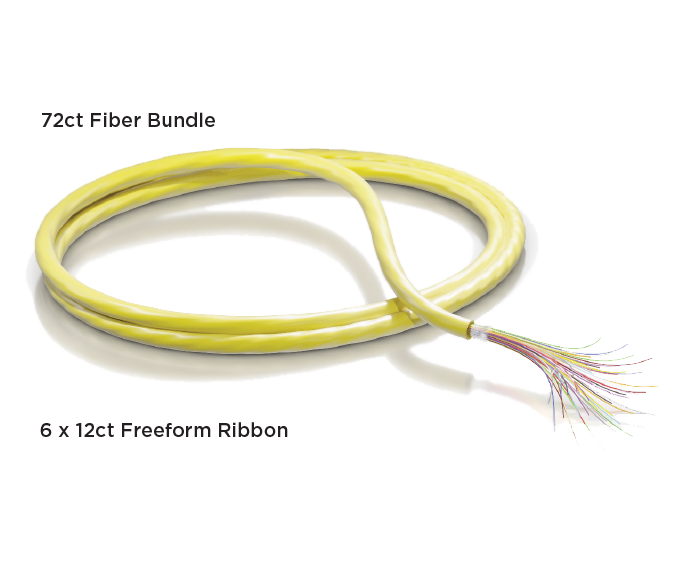
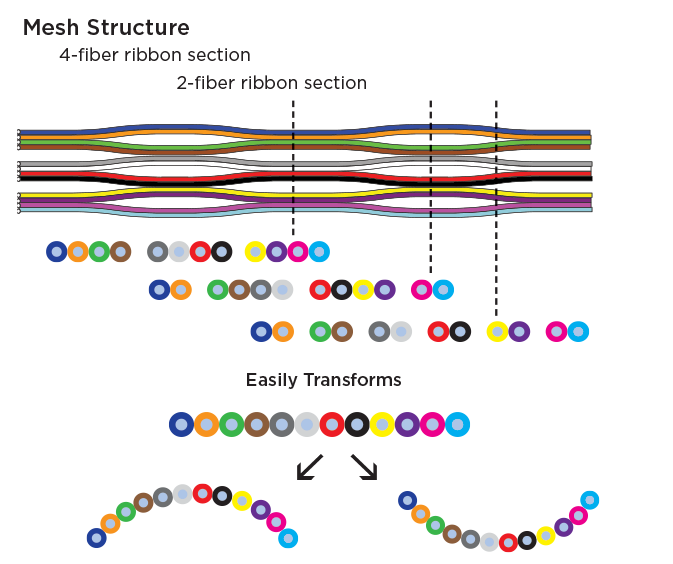
Today fiber bundles of 12 to 72ct are available using the new Freeform ribbon construction. These fiber bundles can be installed in the same tube sizes as their legacy counterparts. When it comes time to do the terminations at the ends is when the benefit of the Freeform ribbon is realized. For example, for one installation of 72ct fiber there would be a total of 144 fibers to terminate, 72 on each end. A single fiber can be fusion spliced on average in two minutes (this includes prep and protection time). To complete 144 fiber terminations would take 288 minutes or nearly five hours. If the fiber bundle construction utilizes 12ct Freeform ribbon, it will only require a total of 12 fusion splices. A 12ct ribbon can be fusion spliced on average in five minutes (this includes prep and protection time). To complete the 144 fibers of 12 x 12ct ribbon splicing would take only 60 minutes or one hour. This equals to an 80% time and labor cost savings!
A compliment of products that have also seen recent innovations take the speed of installation further. Preterminated panels and/or cassettes streamline the fiber to connector terminations required at demarcation points or bulk heads. These products come with the bulk heads or faceplates already loaded with the connectors on the back and with a fiber tail that can be spliced quickly and easily in the field. By having the connectors already terminated and loaded in the bulkhead eliminates the tedious work and lengthy time to perform this in the field. These products are available in both single fiber and 12ct ribbon fiber tails. When combining a Freeform ribbon based fiber bundle and a preterminated panel or cassette with 12ct ribbon to connector fanouts, the terminations are as simple as completing the 12ct ribbon fusion splices. For example, a pre-terminated 2RU with 144 LC SMF ports can be fed with 2 x 72ct fiber bundles and the terminations complete in only 12 ribbon splices in approximately one hour and no further work is needed as the LC connectors are already installed to the bulkhead. This compares to five hours to perform 144 fiber terminations as well as the time to clean and install each connector into the bulkhead, typically adding an additional hour or two per 144. A total savings of combining Freeform based fiber bundle and pre-terminated solutions yields an 85% or more time and labor cost savings (Fig. 2).
PRE TERM 2RU Panel
Fig. 2
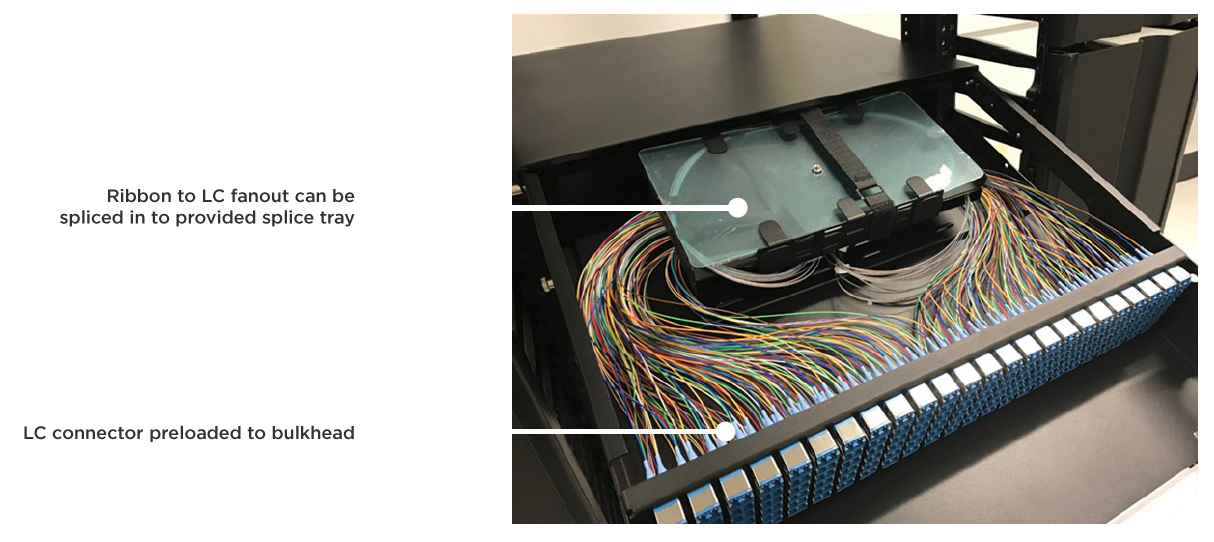
Ensuring networks are deployed and maintained in a safe manner is also important. An accident in the workplace can have multiple devastating consequences including injury to staff, damage to equipment and facilities, loss of services and down time, high costs with insurance, repairs, doctor bills, fines, etc. Bottom line is that accidents are not good for anyone and focused steps need to be taken to ensure work can be done safely. With a lingering pandemic, another dynamic is added to what a safe work environment entails. ABF is a solution that checks all the boxes for meeting network build safety concerns, and even the new concerns specific to the COVID-19 pandemic.
With the tube pathway already in place, installing fiber bundles into existing and available tubes can be done with minimal staff, usually only two people needed, one at each end of the run. There is no need to block off traffic areas or to utilize ladders or lifts to access overhead cable management, which add a level of safety risk in the work environment. New fiber bundle can be installed through pathways running in the riser or plenum space next to or overhead of active work areas. There is no need to shut down work areas to complete these fiber installations and there are no construction debris created from the installations. Relocating active work areas and creating construction debris, is typical with conventional installations; It can be distracting, confusing, and usually require more safety protocols and higher level of vigilance in order to avoid accidents.
With installations only requiring two staff or contractors, and those being at each end of the pathway, there is no challenge in creating the social distancing needed in the COVID-19 pandemic. The ABF solution is an “installation distancing” answer to the COVID-19 pandemic-challenged work environment. A team of contractors working in active work areas are not needed for a successful ABF installation. The two staff needed are at the pathway ends which are typically isolated from the active areas used for the primary function of the facility (Fig. 3).
ABF Tube Cable in Plenum Space
Fiber Bundle blown from computer room A to computer room B with no disruption to active work space.
Fig. 3
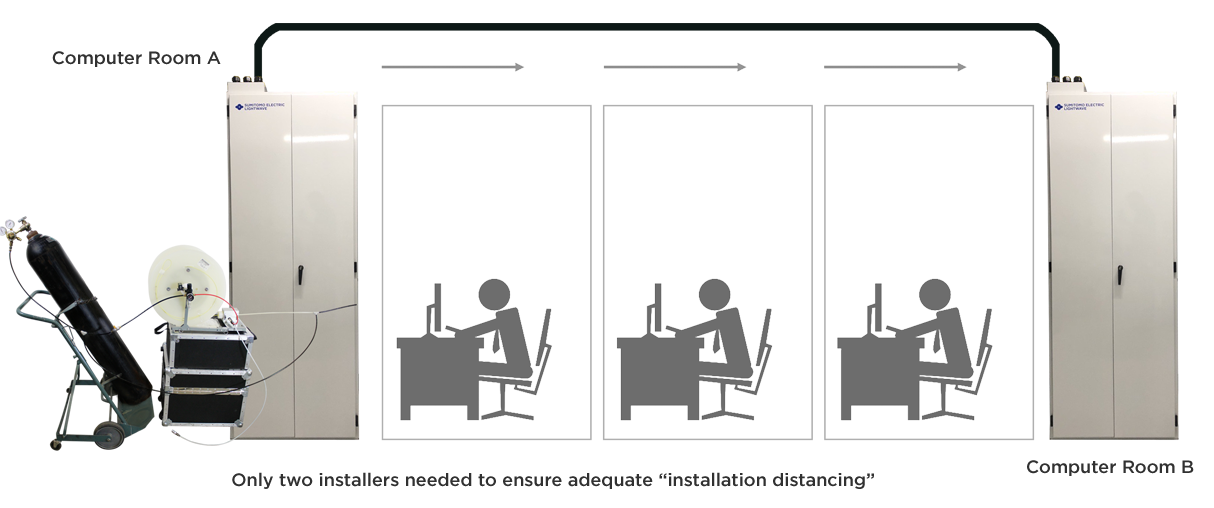
Security is another key consideration, that if not addressed, can lead to costly issues in both financial and time consequences. Many companies have a need for multiple network applications to be installed within their facilities. And at the extreme are Colocation Data Centers with fiber optic infrastructure supporting a number of clients. The ability to keep these discrete networks, whether by application or by client, secure is a top priority. ABF utilizes the tube cable pathway, which has an outer jacket and multiple inner tubes; therefore, each are available to install a fiber bundle. The tube cable pathways come in 2, 4, 7, 12, 19 and 24 tube versions. These tubes can be populated with fiber bundle when the network, application, or customer requires it. This offers a deferred cost benefit during the initial network build as you only have to pay for the exact fibers you need versus installing dark/unused fibers that you pay for up front.
Additionally, each tube offers a much higher level of security compared to conventional cabling methods (Fig. 4).
Fig. 4
Each discrete network can be protected within a dedicated tube.
In this example there are seven discrete tubes available.

In the case of a Colocation Data Center, overhead cable management is populated through the course of time with hundreds and even thousands of cables to manage the constant MACs of the network to meet customer requirements. In these cable management trays, you may find cables supporting different client’s side-by-side: overlapping or being overlapped. Making changes to a cable in this environment carries a level of risk of possibly and unintentionally impacting a neighboring network. With the ABF tube cable system, a new fiber bundle can be installed to support a new network, application, or customer requirement without ever interfering or impacting neighboring networks that are safely protected within their discrete tube. Colocation Data Centers may be the extreme example, but this scenario is also possible at some scale with companies having various discrete networks such as: supporting operations, campus security, IT, Audio and Visual, etc.
The ABF tube cable is available in both non-armored and armored versions. The non-armored already provides a higher level of security for the inner fiber bundles compared to conventional cables where the inner fibers have less layers of robust protection. Adding an armored layer to the ABF tube cable provides even more peace of mind in the security of all fiber bundles and networks: applications and customers being supported within the tube cable. Going further and also adding active monitoring can make for a virtually impervious pathway. A study was performed by Network Integrity Systems on the ABF armored tube cable product.
Their findings were as follows:
“A short background-Network Integrity Systems utilizes patented detection algorithms for monitoring intrusions into a conveyance: Intrusion Signature (IS) is a time domain algorithm for detecting step functions and non-perioding events, and a frequency domain algorithm called Smart Filter Detection (SFD) detects periodic events such as vibrations. We have tested the standard FutureFLEX in the past, and found that the technique for assuring security would be to monitor at least one fiber in every tube.
With the armored version, we observed two things:
1. Once we breached the armor, the system acted very similarly to the last, non-armored test.
2. The metallic armor introduced a substantial layer of security. Firstly, it is a very robust armor, and we found it very time consuming and difficult to breach. Secondly, the armor added a form of detection isolation to the system. When monitored using our SFD algorithm enabled, we were unable to breach the armor to access the inner tubes carrying the data. We performed tests with both single mode and multimode fibers, and the results were very similar.
In summary, when using the Network Integrity Systems INTERCEPTOR™ or VANGUARD™, Fiber Optic Security System monitoring the metallic armored ABF system with the SFD algorithm enabled and auto configured, we were unable to breach the armor in an attempt to access the internal fiber bundles.” The use of monitoring equipment, like the one made available from Network Integrity Systems, is used to create a Protected Distributed System (PDS) by installing it on either end of a fiber optic cable. “A protective distribution system (PDS), is a US government term for wireline or fiberoptics telecommunication system that includes terminals and adequate acoustical, electrical, electromagnetic, and physical safeguards to permit its use for the unencrypted transmission of classified information. The purpose of a PDS is to deter, detect and/or make difficult physical access to the communication lines carrying national security information.”
Many government and other groups, having high security requirements. However, please note that using the combination of Network Integrity Systems products and Sumitomo Electric Lightwave’s Air-Blown Fiber Solution does not automatically qualify a system as a PDS. Secure networks are required to be approved by the appropriate government body, such as CTTA (Certified TEMPEST
Technical Authority) or other approval body depending on specific installation and threat level.
Hopefully this article has given you a fresh look at ABF and how that with recent innovations, the solution has enhanced upon its already high feature and value set. Combining complimentary network components, which have also seen recent enhancements, work cohesively to carry the speed of installation: Safe and secure benefits, as well as reducing costs and delivering on network requirements and high quality all the way through the end-to-end solution.
For more information on Network Integrity Systems and their
products, please visit www.networkintegritysystems.com.

